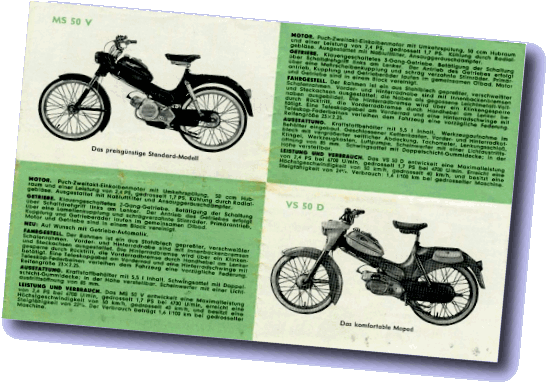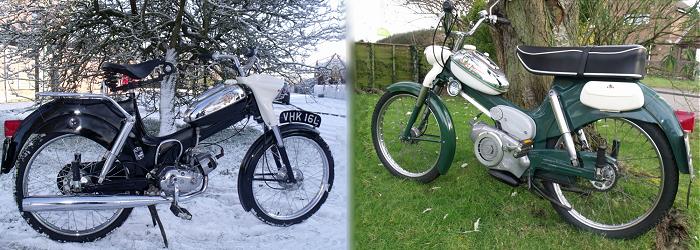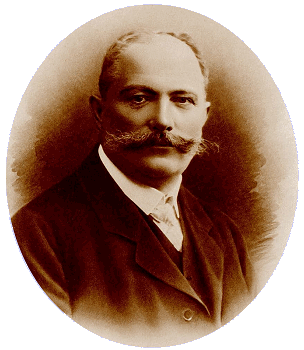 In 1889, a small workshop called Fahrradfabrikation at Strauchergasse 18a in
Graz, Austria, started producing bicycles—its owner’s
name was Johann Puch, so it’s pretty easy to figure out
where this story is going.
In 1889, a small workshop called Fahrradfabrikation at Strauchergasse 18a in
Graz, Austria, started producing bicycles—its owner’s
name was Johann Puch, so it’s pretty easy to figure out
where this story is going.
Ten years later he founded his company Erste Steiermärkische Fahrradfabrik AG—meaning, ‘First Styrian Bicycle Factory’, with the main production plant being built at Puntigam, a district to the south of Graz.
As these things often do, the construction of cycles led on to other things, with manufacture of engines commencing in 1901, followed by the building of cars in 1904. Manufacture of a two-cylinder Puch Voiturette began in 1906 and, in 1909, a Puch car set a new world high-speed record at 130km/h (80mph).
In 1910, sedan limousines were produced for members of the Imperial Family, which now firmly established the Puch Company as a quality manufacturer of social importance.
In 1912 Johann Puch decided to retire from the business, but continued in a role as the company’s honorary president. By this time the business employed some 1,100 workers, annually producing 16,000 bicycles and 300 motor cycles and cars.
During WWI Puch became an important supplier of vehicles to the Austro–Hungarian military, however with the collapse of the Austro–Hungarian Empire following the armistice, their market for automobiles contracted dramatically, and production was discontinued.
Declining sales during the early years of the 1920s found the business struggling through difficult times, and an Italian Engineer, Giovanni Marcellino, was reportedly sent by the banks to wind up business at the Puch factory in Graz. However, within a few weeks, he had settled down to live in the town, designing, and then producing a new version of the split-single engine concept. Taking his inspiration from industrial counter-piston engines, the new motor benefited from improved breathing from asymmetric port timing, developing improved performance upon the original Italian concept by Adalberto Garelli.
Puch won the German Grand Prix in 1931 with a supercharged split-single, though it became eclipsed by DKW split-single racers in subsequent years.
In 1928 the Puch Company had merged with Austro–Daimler to become part of Austro–Daimler–Puchwerke, which in turn merged with Steyr AG in 1934, now to form Steyr–Daimler–Puch.
During WWII, practically all industrial plants under Axis control became turned over to military direction, and the Puch factories were switched to arms production. The existing capacity was considered insufficient, so a second factory was built at Thondorf, another district of Graz, and commenced manufacturing operations in 1941.
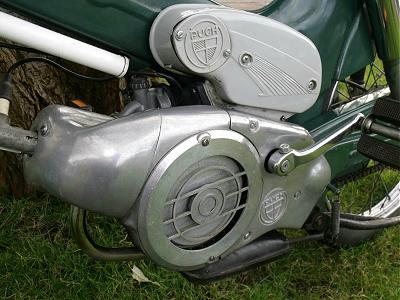 Puch was one of the Steyr–Daimler companies to
benefit from wartime forced labour housed in the
Mauthausen–Gusen concentration camp system during
WWII, where slaves from the
camp (who had previously been worked to death in quarries)
started to become deployed in a highly profitable operation used
by 45 engineering and war-effort companies, among whom Puch
benefited with another new underground factory built at Gusen in
1943.
Puch was one of the Steyr–Daimler companies to
benefit from wartime forced labour housed in the
Mauthausen–Gusen concentration camp system during
WWII, where slaves from the
camp (who had previously been worked to death in quarries)
started to become deployed in a highly profitable operation used
by 45 engineering and war-effort companies, among whom Puch
benefited with another new underground factory built at Gusen in
1943.
During the period immediately following the war, from late 1945–47, the factory was requisitioned and run by the British Army (REME) who used the facilities and remaining workforce for the repair and service of British and American military vehicles within the occupied zone, after which the plant was returned to industrial and commercial use.
To re-commision the Puch factories, an assembly co-operation agreement was signed with Fiat of Turin in 1949, which was followed by a progressive increase in production of Puch-branded bicycles, motor cycles and mopeds throughout the 1950s.
In autumn of 1952, Puch began the design work toward a new moped, culminating in the presentation of the first pre-production model duringthe summer of 1954.
Developed by Walter Kuttler, the two-speed MS50 introduced a distinctive fan-cooled engine which became the basis for a number of other moped models and small scooter variants, VS, DS, VZ-sport, MV, MC, X50, and others.
Our first featured bike is a three-speed MS50 dated 1972, and finished in the classic colours of this time: green & cream.
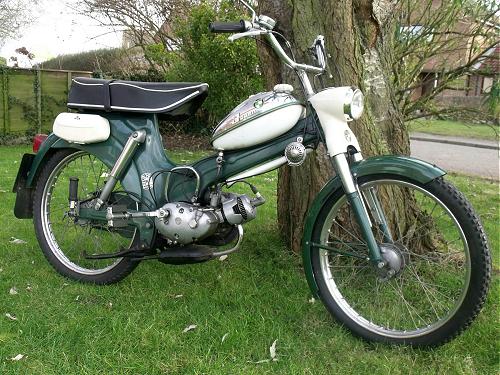 MS models are
Puch’s ‘economy’ versions of their fan-cooled
range, generally being characterised (but not always), by half
width hubs, a small headlamp nacelle, pan-style silencer with
small twin-pipe outlets, and lighter weather protection valances
on the mudguards.
MS models are
Puch’s ‘economy’ versions of their fan-cooled
range, generally being characterised (but not always), by half
width hubs, a small headlamp nacelle, pan-style silencer with
small twin-pipe outlets, and lighter weather protection valances
on the mudguards.
Starting is a familiar procedure, petrol tap off–on–res at right side of the tank. Ignore the float chamber flood button unless it’s numbingly cold, and just flip on the choke lever at the back of the carb. A firm push down on a pedal and she fires up first time, then leave to tick-over for a while, while we get kitted up.
The motor strums slowly and patiently despite the choke, and is still running steadily when we return. Many other machines would probably have spluttered to a halt within this time on choke, but our Puch is commendably well behaved.
Open out the choke and blip the throttle a couple of times to clear the twin outlet pipes with jets of two-stroke smoke. The exhaust seems commendably quiet, so much so that we wonder if the silencer might be gunged up?
Clutch in, twist forward to first for our first clunk of the day, as we re-acquaint ourselves with the infamous clunk-a-matic gearchange. Yes, they all do it!
Initial pull-off seems strong and confident in low ratio, which will take the bike up to around 15mph. Clutch in for the change back through neutral and up to second, which takes a little ‘feeling about’ for, but you know when you’ve found since a clunk from the box indicates the gear has gone home. Let out the clutch and second takes the speedo up to 22ish, then its time for third.
 Top gear finds our
mount a little disappointingly weak on pull, and four-stroking
toward the upper end of the revs … perhaps it’ll
improve as the engine gets hot … but after a couple of
miles, we’re not so sure it will really get any
better. We don’t particularly recall these fan-cooled
models being prone to four-stroking issues, and it seems the
motor might be running a little rich—a glance down tells
everything you need to know. It’s got one of those
infernal adjustable main jets! Wretched things,
you’re forever tuning them in to suit different
temperatures and conditions, but most of the time the carb is
just out of tune and the engine doesn’t run right.
All the carb wants is the correct standard jet, then leaving
alone!
Top gear finds our
mount a little disappointingly weak on pull, and four-stroking
toward the upper end of the revs … perhaps it’ll
improve as the engine gets hot … but after a couple of
miles, we’re not so sure it will really get any
better. We don’t particularly recall these fan-cooled
models being prone to four-stroking issues, and it seems the
motor might be running a little rich—a glance down tells
everything you need to know. It’s got one of those
infernal adjustable main jets! Wretched things,
you’re forever tuning them in to suit different
temperatures and conditions, but most of the time the carb is
just out of tune and the engine doesn’t run right.
All the carb wants is the correct standard jet, then leaving
alone!
Another issue with this bike is that it’s been geared-up for more leisurely cruising, which really isn’t helping when the motor seems down on power. Standard final drive sprockets are 12T front to 34T rear, but this bike is running 13T front to 32T rear, and equates to a ratio increase of 14%—which may prove a little too much under the circumstances.
The 45mph VDO speedometer seemed to give variable and only approximate readings when compared to the results from our pace vehicle, which recorded best on flat in upright position as 31mph, and 32 in a crouch, while our VDO seemed to think this was 34.
Tucked in for our downhill run, it wasn’t so easy to see the speedo needle wavering somewhere past the 35 marker, which our pacer clocked off at 37mph, but further revs were capped by a four-stroking barrier which the motor was obviously never going to get through.
Our uphill climb faded dramatically … revs falling away … this isn’t going to make it. Nope! Our MS found nowhere to hide its embarrassment as we had to change down to second to crawl over the crest at just 18mph.
What a poor show, it should have gone better than this!
We test-run bikes in all conditions, and turning into a hailstorm headwind after topping the climb again found our mount struggling against adverse elements, and there’s no question this example really wasn’t giving its best.
General handling and ride ability were quite good, the dual seat helping in being able to find a more suitable riding position, though the high pedal shaft location contributed to creating some discomfort in the first place. Many people find these fan-cooled models uncomfortable because of the high pedal position, and they really don’t suit tall riders or those with creaking hips so well.
Both brakes were good, the back-pedal rear being particularly strong, but seemingly insensitive to light control.
The basic MS fan-cooled Puch models have been around longest, but their success soon led to the development of more up-market versions.
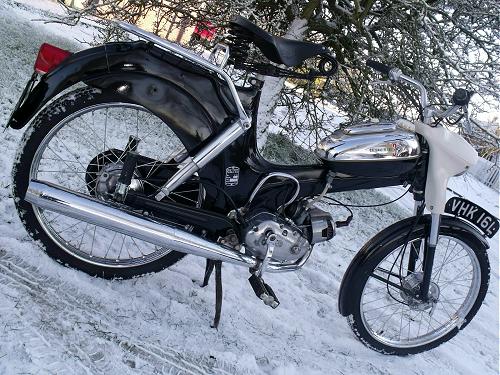 Our second tester is
a British market VS50D, which was basically a De Luxe version of
the MS50. The VS50 still uses exactly the same
specification three-speed, hand-change, fan-cooled motor,
it’s just that the cycle fittings are better appointed.
Our second tester is
a British market VS50D, which was basically a De Luxe version of
the MS50. The VS50 still uses exactly the same
specification three-speed, hand-change, fan-cooled motor,
it’s just that the cycle fittings are better appointed.
The Teutonic pattern cast aluminium fork & headlamp nacelle is a much more elaborate affair on the VS model, this one is appreciably larger, more elaborate, and comes with all the bells, whistles, twiddly bits, mullions, transoms, decorative finials, guttering and gargoyle waterspouts, though doesn’t actually have any further purpose other than being more ornamental.
Instead of the MS ‘pan exhaust’ under the motor, the VS has an exhaust pipe running out the right hand side to a conventional torpedo-shaped chrome silencer. The VS mudguards are more weatherproofed with heavier side valances, and its cast aluminium hubs are full width, with finned ribs between the spoke flanges, as also fitted to VZ50 sports models and other upper range machines.
Waving a tape measure and scales in a threatening manner resulted in weights: front 3st 10lb, and rear 5st, which converts to a total of some 55kg, and measuring 71" nose-to-tail (1.8m).
The UK market VS50Ds all came finished in black & cream, standardly fitted with rear footpegs and a dual seat which, while accommodating a passenger, didn’t really leave much practical space for any carrying capacity. Our machine was more suitably adapted to its present requirement with the fitment of a single saddle and continental market rear carrier.
The ‘old style’ Brooks leather saddle top height is 35", while the high pedal shaft centre measures 14" from the ground. With 6" pedal arms, this gives some idea how much your legs will be doubled to just 15" at the top of the pedal stroke, so this wasn’t a cycle intended for practical pedal assistance.
 Being an
old-fashioned type of moped, our VS50D has no ignition switch or
key. Just turn the off–on–reserve fuel lever at
the bottom right of the tank, and flick up the choke lever at
back of the carb. There’s also a flood button to the
top of the float chamber, but it’s inconceivable that
you’d ever need to use that since the choke strangler
proves very capable of enriching the mixture for any cold
starting conditions in the UK, and as you can see from the pictures,
there was certainly some wintry weather when we had this bike
in!
Being an
old-fashioned type of moped, our VS50D has no ignition switch or
key. Just turn the off–on–reserve fuel lever at
the bottom right of the tank, and flick up the choke lever at
back of the carb. There’s also a flood button to the
top of the float chamber, but it’s inconceivable that
you’d ever need to use that since the choke strangler
proves very capable of enriching the mixture for any cold
starting conditions in the UK, and as you can see from the pictures,
there was certainly some wintry weather when we had this bike
in!
A firm downward thrust on a pedal will spin the motor to readily start, but it’s not many seconds before this strangled motor is gasping for air so we quickly ease open the choke shutter and raise the revs with a little throttle to clear the running.
Mount up, pull in the clutch, and brace yourself for the inevitable … if you’ve ridden a geared Puch before you’ll know just what to expect when you go to engage gear. That inevitable clunk, a little lurch, the whining clutch bearing, and sure enough, its wholly typical of the breed.
Despite sounding and feeling pretty horrible in operation, the Puch gears and clutch are generally more robust than the impression they give, but since it’s practically impossible to manage any smooth and soundless change, just about everyone is going to end up despising that gear-change.
Letting out the clutch, the motor pulls strong and hard on throttle, but is the gear-change going to get any better as we go up the box? No, absolutely not, they’re clunky and whiney on every shift, going up or going down, and most of the effective acceleration is likely to be lost again in the next upward change-crunching and grinding around in the box trying to find the next ratio.
It’ll probably be some relief when you’ve worked up to top, then try and leave it there as long as possible.
Locational/engagement difficulties with the gears are often made somewhat worse by a worn indexing plate in the hand-change control (a very common problem with many machines), and selection is markedly improved by replacement of the plate, though they are also prone to rapid wear—so the problem will invariably return again.
Marks the Puch loses for its clonky gear-change are somewhat made up in its ride. Handling is firm and sure footed, cornering is confident, and braking is good from both the front and rear full-width alloy hubs, though fine control of the rear brake again proves rather difficult to judge with the back pedal arrangement.
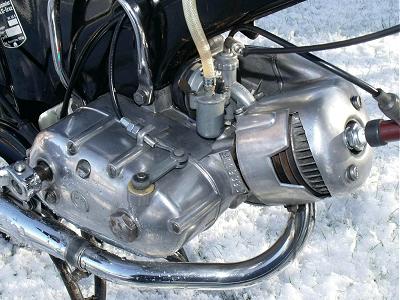 Comparison checks with our pace bike quickly established
this 45mph VDO speedo was
generally indicating a little slow, the ‘general’
aspect being that the needle also tended to waver once past its
30mph marker, so introduced a
degree of ‘guesstimation’ to our indicated
readings. On-flat readings in upright position found our
needle swinging between 30–35, while the pace bike clocked
our best upright at 34, and then working up to a best on flat in
full crouch paced at 37.
Comparison checks with our pace bike quickly established
this 45mph VDO speedo was
generally indicating a little slow, the ‘general’
aspect being that the needle also tended to waver once past its
30mph marker, so introduced a
degree of ‘guesstimation’ to our indicated
readings. On-flat readings in upright position found our
needle swinging between 30–35, while the pace bike clocked
our best upright at 34, and then working up to a best on flat in
full crouch paced at 37.
The downhill run had the needle wavering around our 40 marker, while the tracking pace bike read this section off at actual 41mph. Now at full steam, VS charged confidently into the uphill climb, easily holding third all the way up, dropping back to an indicated 23/actual 24.
This VS was running on a 13T front drive sprocket (up from 12T), to a standard 34T rear, which meant its drive ratio was raised by 8.3% over original spec, a factor to consider for interpretation of the above performance results.
This VS50D went appreciably better than our earlier MS tester, and illustrated some considerable variation as to how two comparable specification machines actually performed
Completing an incredible production run of 28 years, all Puch fan-cooled models were finally discontinued in 1982.
The fan-cooled Puch motor had proved itself to be robust and durable in service, but in the end its now dated design, complexity of component assembly, and high manufacturing cost, made it uncompetitive in an ever shrinking market place.
Changing times were steadily catching up with Puch. The main business was taken over by Piaggio in mid 1987, who discontinued the entire Austrian Maxi model range in September 1987, to resume manufacture of restyled Maxi models again in Italy, continuing the moped for another 10 years, before winding up the last Italian Maxis in 1997.
Puch also licensed out the design rights and sold its entire Super-Maxi assembly line to Hero Motors in India, where manufacture resumed in 1988 up till 2003 when production ended.
As Piaggio concluded their last Italian Maxis, they further licensed out the Maxi engine design, this time to Motor Manet of Slovakia, including sale of the entire Italian engine production line, which was moved to the Považská Bystrica factory in Slokia, which had previously produced the Babetta moped.
A new frame was developed for their new Manet Korado budget moped, with the re-incarnated-yet-again Maxi motor—though there were some quality issues with early production.
Manet further negotiated rights for the ‘Super-Maxi’ engine variant as used in the Puch Magnum-X and Turbo models, etc, returning this motor type to production for greater power, an extended model range, and improving quality.
The Manet Korado was brought into the UK during the late 1990s by the Jawa/CZ importer Motokov UK, and continued in production up to 2008 when the Považská Bystrica factory ended moped manufacture in favour of building light agricultural equipment as VVED.
Another version of the Super-Maxi was licensed out by Puch just prior to its closure in 1987, to be sold under a ‘Maxwell’ brand in Turkey from 1988.
